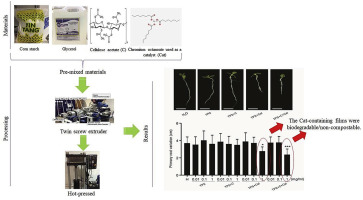当前位置:
X-MOL 学术
›
Food Hydrocoll.
›
论文详情
Our official English website, www.x-mol.net, welcomes your
feedback! (Note: you will need to create a separate account there.)
Characterization of biodegradable/non-compostable films made from cellulose acetate/corn starch blends processed under reactive extrusion conditions
Food Hydrocolloids ( IF 11.0 ) Pub Date : 2019-04-01 , DOI: 10.1016/j.foodhyd.2018.10.024 Clémence Herniou--Julien , Julieta R. Mendieta , Tomy J. Gutiérrez
Food Hydrocolloids ( IF 11.0 ) Pub Date : 2019-04-01 , DOI: 10.1016/j.foodhyd.2018.10.024 Clémence Herniou--Julien , Julieta R. Mendieta , Tomy J. Gutiérrez

|
Abstract The manufacture of food packaging materials from food hydrocolloids has been widely studied during the last decades and multiple alternatives have been investigated, with research mainly focusing on improving the physicochemical and mechanical properties of the different materials. Processing food hydrocolloids by reactive extrusion (REx) for the development of food packaging has, however, been poorly studied. Four film systems were prepared from corn (Zea mays) thermoplastic starch (TPS) containing either cellulose acetate (C) or chromium octanoate (Cat - a potential food grade catalyst), or a blend of both (C + Cat). Processing was done under REx conditions using a twin-screw extruder. An exhaustive study of the resulting materials was carried out in terms of the structural, physicochemical, thermal, surface, mechanical and compostable properties related to their potential use in food packaging applications. The most hydrophobic material was the C-containing film. However, this physicochemical behavior was different on the film surface, thus suggesting molecular rearrangements within the material. The Cat-containing films were darker than the other materials. The mechanical behavior observed in the Cat-containing films was particularly interesting as it suggests that these film systems could be used as shape memory materials for food packaging applications, as long as the following mechanical conditions are not exceeded: 5.02% strain and 0.43 MPa stress. All the films tested were biodegradable. We confirmed that Cat-containing film systems produced non-compostable materials at high concentrations (1 mg/mL), as measured by its effect on lettuce seedlings. This confirms that biodegradable materials are not necessarily compostable.
中文翻译:

在反应挤出条件下加工的醋酸纤维素/玉米淀粉混合物制成的可生物降解/不可堆肥薄膜的表征
摘要 在过去的几十年中,食品水解胶体制造食品包装材料得到了广泛的研究,并研究了多种替代品,研究主要集中在改善不同材料的理化和机械性能。然而,通过反应性挤出 (REx) 加工食品水胶体以开发食品包装的研究很少。四种薄膜系统由含有醋酸纤维素 (C) 或辛酸铬 (Cat - 一种潜在的食品级催化剂) 或两者 (C + Cat) 的混合物的玉米 (Zea mays) 热塑性淀粉 (TPS) 制成。使用双螺杆挤出机在 REx 条件下进行加工。从结构、物理化学、热、表面、与它们在食品包装应用中的潜在用途相关的机械和可堆肥性能。最疏水的材料是含碳薄膜。然而,这种物理化学行为在薄膜表面上是不同的,因此表明材料内的分子重排。含猫的薄膜比其他材料更暗。在含有 Cat 的薄膜中观察到的机械行为特别有趣,因为它表明这些薄膜系统可以用作食品包装应用的形状记忆材料,只要不超过以下机械条件:5.02% 应变和 0.43 MPa 应力. 所有测试的薄膜都是可生物降解的。我们证实,含 Cat 的薄膜系统可产生高浓度 (1 mg/mL) 的不可堆肥材料,通过其对生菜幼苗的影响来衡量。这证实了可生物降解的材料不一定是可堆肥的。
更新日期:2019-04-01
中文翻译:

在反应挤出条件下加工的醋酸纤维素/玉米淀粉混合物制成的可生物降解/不可堆肥薄膜的表征
摘要 在过去的几十年中,食品水解胶体制造食品包装材料得到了广泛的研究,并研究了多种替代品,研究主要集中在改善不同材料的理化和机械性能。然而,通过反应性挤出 (REx) 加工食品水胶体以开发食品包装的研究很少。四种薄膜系统由含有醋酸纤维素 (C) 或辛酸铬 (Cat - 一种潜在的食品级催化剂) 或两者 (C + Cat) 的混合物的玉米 (Zea mays) 热塑性淀粉 (TPS) 制成。使用双螺杆挤出机在 REx 条件下进行加工。从结构、物理化学、热、表面、与它们在食品包装应用中的潜在用途相关的机械和可堆肥性能。最疏水的材料是含碳薄膜。然而,这种物理化学行为在薄膜表面上是不同的,因此表明材料内的分子重排。含猫的薄膜比其他材料更暗。在含有 Cat 的薄膜中观察到的机械行为特别有趣,因为它表明这些薄膜系统可以用作食品包装应用的形状记忆材料,只要不超过以下机械条件:5.02% 应变和 0.43 MPa 应力. 所有测试的薄膜都是可生物降解的。我们证实,含 Cat 的薄膜系统可产生高浓度 (1 mg/mL) 的不可堆肥材料,通过其对生菜幼苗的影响来衡量。这证实了可生物降解的材料不一定是可堆肥的。









































 京公网安备 11010802027423号
京公网安备 11010802027423号